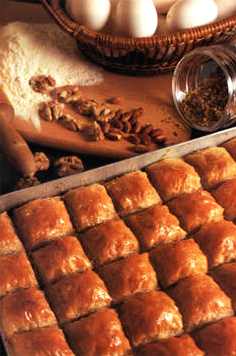|
|
|
|
|
 Of all
Turkey's delicious sweet confections, the most famous is baklava. This exquisite
flavored pastry has been made in Anatolia for long centuries, and its ancestor may be a
dish made by the Assyrians consisting of dried fruit sandwiched between two layers of
pastry and baked in the oven. The earliest record of baklava as we know it today locates
it in Damascus, from which city it spread to Gaziantep and from there to the rest of
Turkey. Exactly when and how this happened is matter for debate. Nadir Güllü, head of
the famous family firm of baklava makers, Güllüoğlu, relates that his ancestor Hacı
Mehmed Güllü first tasted baklava in Damascus on his way to Mecca to perform the
pilgrimage. He remained there for six months to learn how it was made, and introduced it
to Gaziantep. The baklava of this city is made with even thinner layers of pastry, and
filled with the fine quality pistachio nuts which grow in this region. Of all
Turkey's delicious sweet confections, the most famous is baklava. This exquisite
flavored pastry has been made in Anatolia for long centuries, and its ancestor may be a
dish made by the Assyrians consisting of dried fruit sandwiched between two layers of
pastry and baked in the oven. The earliest record of baklava as we know it today locates
it in Damascus, from which city it spread to Gaziantep and from there to the rest of
Turkey. Exactly when and how this happened is matter for debate. Nadir Güllü, head of
the famous family firm of baklava makers, Güllüoğlu, relates that his ancestor Hacı
Mehmed Güllü first tasted baklava in Damascus on his way to Mecca to perform the
pilgrimage. He remained there for six months to learn how it was made, and introduced it
to Gaziantep. The baklava of this city is made with even thinner layers of pastry, and
filled with the fine quality pistachio nuts which grow in this region.By the 17th century at least the fame of baklava had spread to Istanbul, since towards the end of that century baklava was being made by the palace cooks as a special treat for the janissaries in Ramazan. The janissaries carried the trays of baklava out of the palace in what was known as the Baklava Procession. During the reign of Sultan Süleyman the Magnificent (1520-1566), the soldiers had been given a large meal of pilaf, lamb stew and saffron flavored rice pudding (zerde) before setting out on campaign, and in time, this tradition was replaced by the distribution of baklava during Ramazan.
The fit tray was taken by the master armourer and his officers in the name of the sultan, who was himself first janissary. After that the others would be picked up in turn by pairs of soldiers, and each unit with their officers would line up for the parade, followed at the back by the soldiers holding the trays of baklava. They would march out of the palace gate and down the main road known as Divanyolu to their barracks with great pomp and glamour, watched by huge crowds. The following day the empty trays and cloths would be returned to the palace.' In later years the Baklava Procession deteriorated into a noisy and disorganized occasion, and the trays and cloths were no longer returned, with excuses like, 'the baklava was so tasty we ate the trays and cloths as well.' However, despite its unprepossessing end, the procession was one of the interesting customs of Istanbul in the past.
Baklava has spread so far and wide that today it is to be found and eaten with relish in approximately one-fifth of the world's countries. It is surprising, for example, to find that baklava is popular in Texas, where it was introduced in the 19th century by Czech migrants. Less surprising is its prevalence throughout the Arabian peninsula, North Africa, the Turkic republics of Central Asia, Greece, Albania, Macedonia, India, Afghanistan and Armenia. However, there is an important difference between the baklava made in all these countries and that of Turkey - the thickness of the pastry layers. In Turkey the sheets of pastry for baklava are rolled out so thinly that when held up the person standing behind can be seen as if through a net curtain. Elsewhere a thicker pastry known as phyllo (a Greek word meaning 'layer') of the type used in Turkey for savory layered pastries, is used for baklava, which gives a coarser texture and flavor.
This is so that the lozenge does not break in two. The crunch made by the fork as it penetrates the crisp layers is another pleasure which should not be allowed to pass unnoticed. As you lift the piece to your mouth you should halt to savour the fragrance - which should be dominated by the wonderful aroma of cooked butter. Finally you pop it into your mouth and the baklava experience is complete as the flavor pervades your palate.If there is no crunch when your fork and teeth penetrate the baklava, then it is stale. Well made baklava should melt in the mouth, and should not be excessively sweet or syrupy. And if you get heartburn afterwards, then change your supplier, because that means they are not using the finest quality ingredients. |
| Source: Skylife 10/2000 |
| |
Our Hotel | Turkey | Cappadocia | Daily Tours | Views | Guestbook | Request Form | Home |